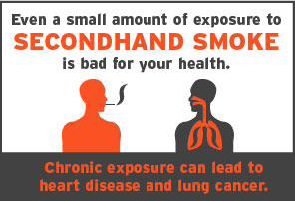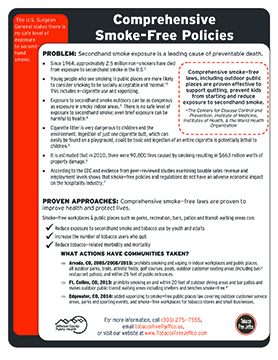Secondhand Smoke Dangers
There is No Safe Level of Exposure to Secondhand Smoke
While Colorado’s Clean Indoor Air Act has increased the protection of Coloradans by prohibiting smoking in restaurants and bars, too many people are still exposed to secondhand smoke (SHS) and the aerosol from electronic smoking devices (ESDs) – at work, during recreation and in outdoor seating areas such as restaurant patios. Below are facts about the impacts of SHS and how smoke-free laws protect citizens from the dangers of SHS. In addition to the harmful effects of SHS, new research has found that, long after a smoker leaves the premises, toxic chemicals from SHS remain and turn into something even more deadly: thirdhand smoke.
Resources
Secondhand Smoke is Harmful
Third-hand Smoke
Did you know that the harmful effects of secondhand smoke linger long after the smoke has dissipated? This is called “third-hand smoke” (THS).
- Researchers at University of California, Riverside found that THS toxicants in the environment had effects on various physiological processes including healing of wounds, function of the liver and lung, and the effects on behavior. Learn more about the study here.
- A study in the journal Tobacco Control found evidence indicating that third-hand smoke may play a role in the overall exposure of young children to tobacco smoke toxicants.
Sources:
1. U.S. Department of Health and Human Services. The Health Consequences of Involuntary Exposure to Tobacco Smoke: A Report of the Surgeon General. Atlanta: U.S. Department of Health and Human Services, Centers for Disease Control and Prevention, Coordinating Center for Health Promotion, National Center for Chronic Disease Prevention and Health Promotion, Office on Smoking and Health, 2006.
2. Institute of Medicine. Secondhand Smoke Exposure and Cardiovascular Effects: Making Sense of the Evidence. Washington: National Academy of Sciences, Institute of Medicine, 2009.
3. Centers for Disease Control and Prevention. Smoking-Attributable Mortality, Years of Potential Life Lost, and Productivity Losses—United States, 2000–2004. Morbidity and Mortality Weekly Report 2008;57(45):1226–1228.
4. US Environmental Protection Agency. Respiratory Health Effects of Passive Smoking: Lung Cancer and Other Disorders . Washington: US Environmental Protection Agency, Office of Research and Development, Office of Health and Environmental Assessment, 1992.
5. Klepeis N.E., Ott W.R., and Switzer P. (2007) “Real-Time Measurement of Outdoor Tobacco Smoke Particles,” Journal of the Air and Waste Management Association, 57:522-534.
6. “[S]moking bans are justified for health reasons in those outdoor environments which are similar to indoor environments in terms of their exposure to environmental tobacco smoke (ETS).” Bloch & Shopman, Outdoor smoking bans: more than meets the eye, Tobacco Control, 9:99, March 2000.


